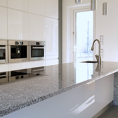Decades of Countertop Material Evolution
The Role of Countertops in Kitchen and Bathroom Design Countertops have been an important component of kitchen and bathroom design for hundreds of years. Since natural stone and engineered surfaces, the history of countertop materials has been filled with innovation in durability, aesthetics, and practicality. We’re going to take a little trip through the decades and see how countertops have evolved.
1920s–1940s: Wood and Ceramic Tile Era
Wood and ceramic tile were the primary top choices in the early 20th century.
- Wood countertops were popular, particularly butcher block, because of cost and ease of use.
- Ceramic tile provided a way to have a stylish, easy-to-clean surface, usually in smaller tiles with prominent grout lines.
Whereas these materials served well, they were not long-lasting, and needed frequent repairs.
The Rise of Laminate, 1950s–1960s
The post-war bonanza of the 1950s brought laminate countertops, like Formica, which in short order became an American kitchen standard.
- Pros of laminate: Low price point, comes in a variety of colors and patterns, and easy to install.
- Cons: Can scratch, burn or peel over time.
By the 1960s, homeowners were looking for streamline and modern kitchen designs, and laminate met that need with its versatility and variety of color.
1970s–1980s: The Rise of Natural Stone
Granite and marble started becoming popular, especially with high-end homeowners, by the 1970s.
- Granite countertops soon became coveted for their durability, heat resistance and classic style.
- Marble, on the other hand, was beautiful but more high-maintenance, given its porousness.
While laminate was still the top pick for budget-conscious homeowners, natural stone was gaining a reputation as a premium choice over these years.
1990s–2000s: The Quartz Revolution
Engineered stone countertops began being popular in the late 1990s and early 2000s, especially quartz.
Why quartz became popular:
Stronger and less porous than natural stone.
Comes in several colors and patterns.
Easy to care for, and highly resistant to stains and scratches.
Solid surface materials such as Corian also became popular, providing seamless designs including sinks that are part of the surface.
2010s–Present: Modern Innovations and Sustainability
Sustainability, durability and aesthetics have all been top priorities when it comes to countertop options for homeowners over the last ten years.
- Porcelain countertops have become a leading contender thanks to their incredible durability, heat resistance and lightweight construction.
- Homeowners looking to go green are turning to recycled materials that include recycled glass and composite countertops.
- Ultra-compact surfaces, such as Dekton, offer great resistance to heat, stains, and UV rays, so you can use them indoors or outdoors.
Countertop Materials of the Future
We’re sure to see even longer-lasting, sustainable and multifunctional countertop materials with advances in technology. Emerging technologies like integrated wireless charging, smart surfaces, and antimicrobial coatings are paving the way for the next evolution of kitchen and bathroom countertops.
Whether you’re inspired by the timeless beauty of natural stone or the sleek functionality of engineered surfaces, the development of countertop materials leave no shortage of variety for every style, need, and preference. But as trends and technology march relentlessly onwards, one thing has been for sure — countertops are going to be a building block of home design for decades to come.






